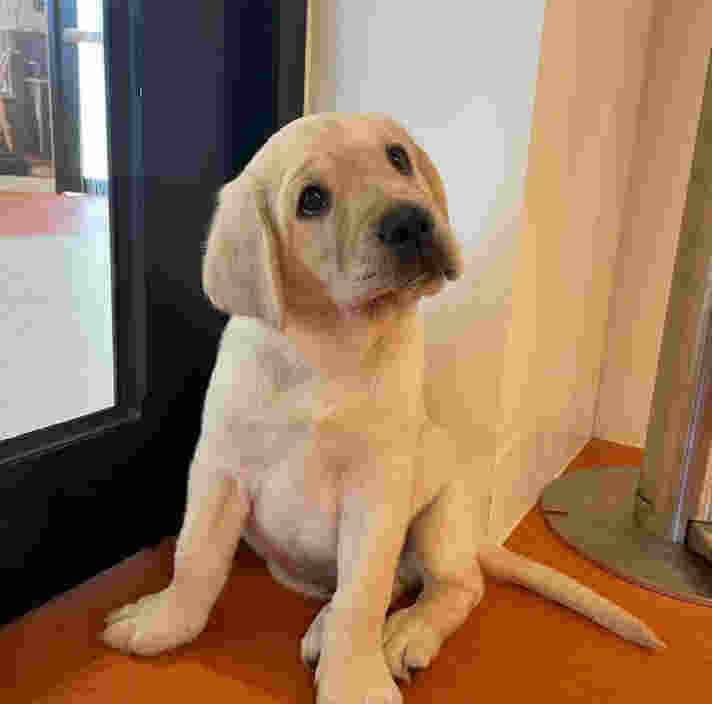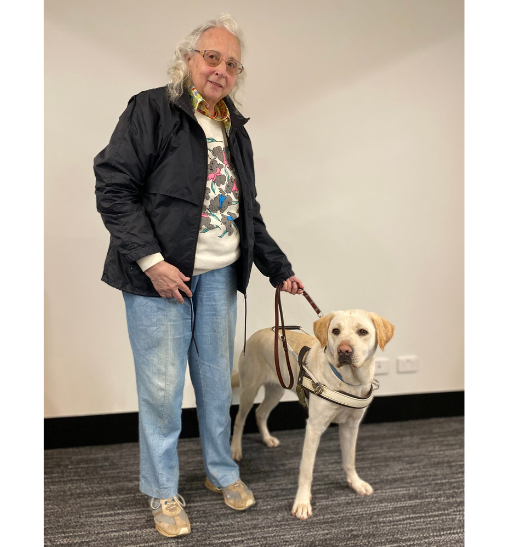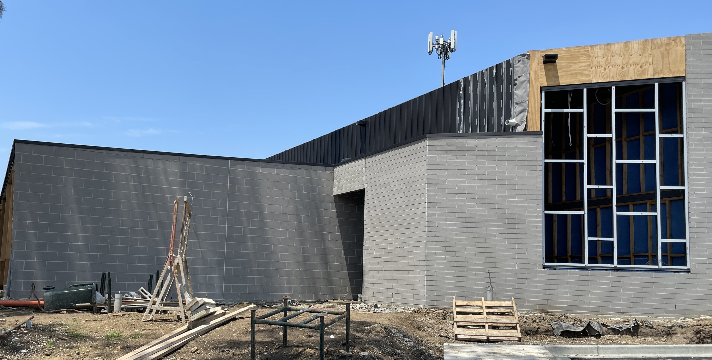Welcome
Catching the Guide Dogs bug.
Hello, my name is Sue and I became involved with Guide Dogs in 2002 as a Puppy Raiser with my very first Labrador pup named Crystal. She was our first introduction to Labradors as we had other breeds as pets beforehand.
Crystal also began my dedication to helping raise these gorgeous pups with the special outcome of becoming Guide Dogs.
I have had quite a few voluntary roles, including puppy nurturer (this is where I came to the campus to cuddle the puppies and got them used to contact with people); puppy deliverer to first-time raisers; broody stockholder (this is looking after our gorgeous mums as they deliver the next generation of working Guide Dogs); and assistant to the instructor at puppy classes. I felt very proud and honoured to help out in these roles and, of course, loved it all.

In my time as a Puppy Raiser volunteer with Guide Dogs, I have raised 19 pups, all with a mixture of career paths. I have currently raised two breeding dogs (Heidi and Hannah); four Guide Dogs (Cajun, Varyn, Ilsa and Okie); five Therapy Dogs (Crystal, Zandrie, Angel, Willa and Oreo), one Ambassador Dog (Zoron); six pets (Darcy, Tully, Volku, Kossack, Alira and Kolby, who is now our family pet) and we are currently raising a beautiful girl pup called Melody.
The staff at Guide Dogs have always been very welcoming and helpful with everything I do and always approachable with any queries or advice. Over the past 20 years as a volunteer I have met and become friends with many like-minded people who also love giving back to the low vision or blind community.
I hope to spend many more enjoyable years raising pups for their important roles at Guide Dogs. After 19 pups it’s clear that I have cemented my love for Guide Dogs.
Kind regards,
Sue
Our cover star: Bentley
Our latest cover star is Bentley. He is just starting his journey to becoming a life-changing Guide Dog or Therapy Dog. Your support for dogs like Bentley can help bring independence and freedom to a person with low vision or blindness.

Monica Behrend: member of the Otus Fellowship and Guide Dog Partner.
Our supporters are the lifeblood that keeps our mission alive and thriving. In this edition we have the privilege of shining a spotlight on Monica Behrend, a remarkable supporter of Guide Dogs, whose philanthropic spirit has had an incredible mark on our organisation.
Monica started supporting Guide Dogs in her early years with her late mother who had a deep passion for supporting people living with blindness or low vision.

This history of philanthropy and a deep passion for the work Guide Dogs does is why Monica has been a dedicated supporter of Guide Dogs for more than 55 years. Monica has made the very generous decision to include a gift in her Will to Guide Dogs as well as being a Guide Dog Partner, supporting the breeding and training of dogs Daisy, Taj, Felix and Monsie.
Monica’s generosity serves as a wonderful example of what one individual can achieve when they believe in a cause. We hope that Monica’s generosity will inspire others to join us in making a difference.
If you would like to become a Guide Dog Partner, please contact Lily Downs on 0448 032 850 or email lilyd@guidedogsvictoria.com.au for a confidential conversation.
Dogs off duty
“From the time I brought him home, my Guide Dog, Jet, very quickly let me know that despite weighing 36 kg, he identified as a ‘lap dog’. While sitting on the couch he would place his head on my knee and wag his tail. I didn’t need to see him to know he was looking up at me with those heart-melting chocolate eyes, hoping I might invite him up for a cuddle.
As a working dog and a big dog, Jet’s not allowed on the couch, so the only option was for me to sit on the floor so he could snuggle in my lap, which he promptly did.
So now, at the end of a workday, we will go home, I’ll make a cup of tea and sit on the floor with a Labrador in my lap, just having a cuddle.
It’s a great way to end the day!”
− Erin and Guide Dog Jett.

Pet tips
Protecting your dog against foreign objects.
Foreign objects are items that can cause obstruction in a dog’s intestines. This can be life threatening by causing damage to the intestine, systemic infection or even cardiovascular shock.
Obstructions can be caused by non-food items such as rocks or batteries, or even food sources, such as corncobs, mango seeds, bones and kebab sticks.
The worst kind of foreign objects is a linear one. This is where the dog has eaten a product that is long and thin, such as a piece of rope or material. With linear foreign objects, several metres of intestine can be damaged as it becomes gathered around the item.
It is important to monitor your dog when they are using any toy that could be ingested and remove any toy that has signs of damage.
For dogs that are destructive, or have a propensity to ingest things, they should not use fabric toys, but larger hard plastic toys that cannot be ingested.
Signs of obstruction include:
- Lethargy
- Vomiting
- Lack of appetite
- Abdominal pain
Should you suspect your dog has eaten something that can cause harm, visit the vet immediately. If the dog has swallowed the item within the past couple of hours, your vet may be able to make them vomit the item up before it causes damage.
Say ‘YES’ to Guide Dog access.
In line with Victorian State Laws, a person with low vision or blindness who is accompanied by a Guide Dog is permitted to:
Travel on any form of public transport; enter any public place; visit any theatre; eat in any restaurant; and shop in any store (including supermarkets and food stores)
The only exceptions where a Guide Dog is not permitted are operating theatres, commercial kitchens and some parts of the zoo.
These laws also apply to people training Guide Dogs and Guide Dog puppies.
At Guide Dogs, we acknowledge that refusal of access to these spaces is something that still causes many Guide Dog Handlers trouble in their everyday life.
Recently we launched our new Guide Dog Handler access cards. These are credit card style cards with the Guide Dogs access information, a picture of the Handler and information about the Guide Dog and qualification date. The card also has a QR code to link to our website for more detailed access information.
If you are a Client of Guide Dogs Victoria and would like one of these cards, please get in contact with your Guide Dog Mobility Instructor.
Campus redevelopment update
Campus redevelopment update.
Guide Dogs Victoria has completed building works on a state-of-the-art Veterinary Clinic, now operational and fitted out by tenant Advanced Vetcare, as well as a new warehouse, on-site café and administration building. The onsite training accommodation, Reception, Experiential Centre, civil works and landscaping, including sensory gardens, are still in progress and expected to be completed mid-year.

Café tenancy available
Guide Dogs Victoria is looking for like-minded café operators for a fantastic opportunity to run our on-site café. The unique café space includes kitchen infrastructure and offers alfresco outdoor dining overlooking the Yarra Trail. The opportunities are endless for catering internally and externally.
Lettable areas are:
- Café tenancy, including store/scullery and toilets: 206 sqm
- Café terrace: 93 sqm
- Landscaped terrace (optional): 250 sqm
For more information, please contact:
Tamara Gross
0411 748 538
tamara.gross@belleproperty.com
or
Nick Mavrodoglos
0402 318 825
nick.mavro@belleproperty.com
Join this valued community destination and be part of the Guide Dogs Family.

In memory
Vale Joan Kennedy Styles
Joan Styles was a loyal Guide Dogs supporter of many years, who sadly passed away last year shortly before her 100th birthday.
As a young girl, Joan was affectionally known as “the girl with dogs”. She adored animals, particularly admiring a dog’s loyalty and love for their owners. Joan almost preferred furry four-legged companions over people!
Joan’s support for Guide Dogs was triggered by a simple yet impactful event: looking out of the window of her home. On the street below, she noticed a person with a Guide Dog waiting at the bus stop. It immediately struck Joan how challenging it must be to navigate the community with low vision or blindness. Shortly afterwards, Joan
felt inspired to contact Guide Dogs and make a significant donation.

Years later, Joan moved into a nursing home where she was visited regularly by her son, Harry, himself a Guide Dogs supporter. Harry kept Joan up to date with all the latest news, even helping arrange for an Ambassador Dog to drop by and meet Joan, bringing her untold joy.
During her later years, Joan began to lose her vision. She made the decision to include a gift in her Will to Guide Dogs which would help provide funding to breed, raise and train future Guide Dogs.
Joan’s legacy lives on through little puppy ‘Kennedy’, born November 2023. Kennedy is now happily settled with her puppy raisers, where the foundation training required to become a life-changing Guide Dog is well under way!
Did you know if you have included a gift of $50,000 or more in your Will to Guide Dogs, you can request to name a puppy in your memory?
Please contact Lily Downs on 0448 032 850 or email lilyd@guidedogsvictoria.com.au for more information.
Eye Health
Spotlight on cataracts
What are cataracta?
The term cataract refers to a progressive clouding of the normally transparent crystalline lens inside the eye.
The role of the lens is to focus light entering the eye on the retina, resulting in a clear image of what it is that the eye is looking at. When the transparency of this lens is reduced by cataracts, light entering the eye is scattered or becomes reduced, resulting in a reduction in vision clarity.
In addition to blurry vision, other early symptoms of a cataract may include an increased sensitivity to glare and a reduction in the vibrancy of colours or ‘yellowing’ of the vision. Over time, as the cataract develops, symptoms such as double vision, image distortion, difficulty driving at night and reading difficulties can occur.
Cataracts are difficult to see in the early stages and require examination by an eye professional with specialised equipment to diagnose them. As they progress, the pupil (the dark central part of the eye) may start to appear cloudy or grey, and in advanced stages of the disease this pupil area may become yellow or white.
In the mature stages, the impact of the cataract on vision is severe and may limit vision so significantly that the sufferer can distinguish the presence of light, but be unable to discern any additional detail.
There are several different types of cataracts and examples of some of these are shown in the figure below.
How common are cataracts and what can be done to treat it?
In rare occasions, babies may be born with a cataract (congenital cataract) or develop one following trauma to the eye. But most cataracts are age-related so it is no surprise that the incidence increases significantly over time. One study found an incidence of 3.9 percent among the age group 55 to 64 years, but this increased to 92.6 percent among those 80 years and older.
Cataracts can be treated with a relatively straight-forward surgical procedure performed by an ophthalmologist. In this procedure, the cloudy lens is extracted and a new artificial lens is inserted in its place. Typically, vision is much clearer within a few hours of surgery, improving further as the eye heals. During this recovery time, prescribed eye drops must be used.
The figure on the right: Shows a small congenital cataract (A), a nuclear cataract (B), dense nuclear cataract (C) and posterior sub-capsular cataract (D). In images A-C you can see a beam of light to the left of the image.

Meet our newest Ambassador Dog
Our newest Ambassador Dog graduate.
Hi, I’m Keith, and I have a very important job as an Ambassador Dog for Guide Dogs. While I am new to being an ambassador after being a puppy, I am loving every minute that I get to be at events and interacting with all our donors.
When I am at events, I get to wear a special jacket that is blue and has my name across it. This jacket is unique to me. Do you know the other types of jackets pups can wear? Pups in training, for example, wear an orange jacket. These pups are learning to become Guide Dogs and cannot be patted when wearing this jacket.
I hope to see you at some upcoming events because without our supporters, we would not be able to people those with low vision or blindness live a life without limits.

Impact
Recycle and help Guide Dogs Victoria at the same time!
Guide Dogs Victoria is proud to be a donation partner of the Victorian Container Deposit Scheme. CDS Vic is part of the Victorian Government’s $515 million investment to transform the state’s waste and recycling sector. Funded by contributions from the beverage industry, the scheme will contribute to Victoria’s target of diverting 80 percent of all material away from landfill by 2030.
There are three zone operators covering the Victorian area.
- North Zone: Visy
- East Zone: Return It
- West Zone: Tomra Cleanaway
To donate:
- Collect eligible containers. Look for the 10 cent mark to confirm eligibility.
- Find your nearest refund point by heading to https://cdsvic.org.au/locations.
- Donate your refund to Guide Dogs Victoria. There are several ways you can donate
to Guide Dogs Victoria via the container deposit scheme
a. Search for Guide Dogs Victoria when donating at a collection point.
b. Download your zone operators free app via your smartphone app store.
c. Scan our donor barcode ID at your nearest collection point.


Pip’s next adventure
Pip is off on her next adventure.
In our last edition of Guide Dog Tales, we introduced you to a special puppy, Pip.
In each edition of Guide Dog Tales, we will have a special section to share Pip’s Puppy Tales with you. You’ll get to follow Pip’s adventures with an exciting story or activity for you or a family member to participate in!
Since leaving her mum and siblings, Pip has been living with a volunteer Puppy Raiser. She is learning new skills each day, including walking on a lead, learning basic commands and wearing her orange training jacket when she is out and about.
Pip will also go with her Puppy Raiser to regular group training sessions and meet with her Puppy Development Advisor to keep track of her progress.

Race to support independence and freedom
Teams from Guide Dogs recently raced to support people with low vision or blindness and had a great time in the process.
In collaboration with XL Events, Guide Dogs Australia has developed ‘Unleashed. Race to support Guide Dogs’.
While team building events are an effective way to build bonds and develop meaningful
connections outside of the office, and many of the best events also support charities, Unleashed goes one step further.
This is more than a race of the fittest. It tests your ability to solve problems in new ways, employing senses other than sight.

Teams are challenged to walk, for just a little while, in the shoes of someone with significant vision loss or blindness by tackling a series of exciting and enlightening challenges.
By the end, participants will have developed a deeper understanding of the critical importance of accessibility and inclusion.
Unleashed aims to educate and engage corporate Australia while assisting them to elevate team spirit and support the critical work done by Guide Dogs.
If you’re interested in strengthening team bonds, rewarding your team members, encouraging accessibility and inclusivity, and supporting people with low vision or blindness, consider booking Unleashed, Race to Support Guide Dogs by visiting xlevents.com.au for more information.

“I really enjoyed the event. I loved the inclusion of vision loss challenges and it was a great team bonding experience.” – Steve
Our Partners
Thank you to our partners:
Your donations to Guide Dogs Victoria help us to continue our important work, including matching Guide Dogs and Therapy Dogs, Orientation and Mobility services and Occupational Therapy through almost 3,000 Client programs.
Ready to continue?
Seems like you have filled this form earlier. Let’s pick up where you left off.















